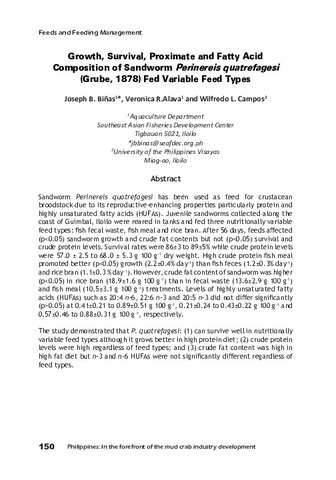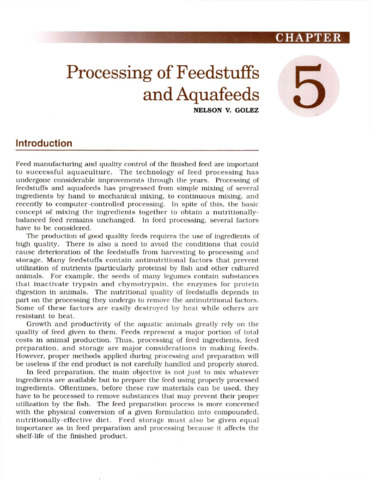Growth, survival, proximate and fatty acid composition of sandworm Perinereis quatrefagesi (Grube, 1878) fed variable feed types
| dc.contributor.author | Biñas, Joseph B. | |
| dc.contributor.author | Alava, Veronica R. | |
| dc.contributor.author | Campos, Wilfredo L. | |
| dc.contributor.editor | Quinitio, Emilia T. | |
| dc.contributor.editor | Parado-Estepa, Fe Dolores | |
| dc.contributor.editor | Coloso, Relicardo M. | |
| dc.date.accessioned | 2017-08-25T09:03:38Z | |
| dc.date.accessioned | 2017-08-25T16:32:55Z | |
| dc.date.available | 2017-08-25T09:03:38Z | |
| dc.date.available | 2017-08-25T16:32:55Z | |
| dc.date.issued | 2017 | |
| dc.identifier.citation | Biñas, J. B., Alava, V. R., & Campos, W. L. (2017). Growth, survival, proximate and fatty acid composition of sandworm Perinereis quatrefagesi (Grube, 1878) fed variable feed types. In E. T. Quinitio, F. D. Parado-Estepa, & R. M. Coloso (Eds.), Philippines : In the forefront of the mud crab industry development : proceedings of the 1st National Mud Crab Congress, 16-18 November 2015, Iloilo City, Philippines (p. 150). Tigbauan, Iloilo, Philippines: Aquaculture Department, Southeast Asian Fisheries Development Center. | en |
| dc.identifier.isbn | 9789719931072 | |
| dc.identifier.uri | http://hdl.handle.net/10862/3185 | |
| dc.description | Abstract only. | en |
| dc.description.abstract | Sandworm Perinereis quatrefagesi has been used as feed for crustacean broodstock due to its reproductive-enhancing properties particularly protein and highly unsaturated fatty acids (HUFAs). Juvenile sandworms collected along the coast of Guimbal, Iloilo were reared in tanks and fed three nutritionally variable feed types: fish fecal waste, fish meal and rice bran. After 56 days, feeds affected (p<0.05) sandworm growth and crude fat contents but not (p<0.05) survival and crude protein levels. Survival rates were 86~c3 to 89~c5% while crude protein levels were 57.0 ~c 2.5 to 68.0 ~c 5.3 g 100 g-1 dry weight. High crude protein fish meal promoted better (p<0.05) growth (2.2~c0.4% day-1) than fish feces (1.2~c0.3% day-1) and rice bran (1.1~c0.3 % day-1). However, crude fat content of sandworm was higher (p<0.05) in rice bran (18.9~c1.6 g 100 g-1) than in fecal waste (13.6~c2.9 g 100 g-1) and fish meal (10.5~c3.1 g 100 g-1) treatments. Levels of highly unsaturated fatty acids (HUFAs) such as 20:4 n-6, 22:6 n-3 and 20:5 n-3 did not differ significantly (p>0.05) at 0.41~c0.21 to 0.89~c0.51 g 100 g-1, 0.21~c0.24 to 0.43~c0.22 g 100 g-1 and 0.57~c0.46 to 0.88~c0.31 g 100 g-1, respectively. The study demonstrated that P. quatrefagesi: (1) can survive well in nutritionally variable feed types although it grows better in high protein diet; (2) crude protein levels were high regardless of feed types; and (3) crude fat content was high in high fat diet but n-3 and n-6 HUFAs were not significantly different regardless of feed types. | en |
| dc.language.iso | en | en |
| dc.publisher | Aquaculture Department, Southeast Asian Fisheries Development Center | en |
| dc.subject | Scylla | en |
| dc.subject | Philippines | en |
| dc.title | Growth, survival, proximate and fatty acid composition of sandworm Perinereis quatrefagesi (Grube, 1878) fed variable feed types | en |
| dc.type | Conference paper | en |
| dc.citation.spage | 150 | |
| dc.citation.conferenceTitle | Philippines : In the forefront of the mud crab industry development : proceedings of the 1st National Mud Crab Congress, 16-18 November 2015, Iloilo City, Philippines | en |
| dc.subject.asfa | brackishwater invertebrates | en |
| dc.subject.asfa | breeding stock | en |
| dc.subject.asfa | crab culture | en |
| dc.subject.asfa | fatty acids | en |
| dc.subject.asfa | feeds | en |
| dc.subject.asfa | feeding experiments | en |
| dc.subject.asfa | fishmeal | en |
| dc.subject.asfa | cultured organisms | en |
| dc.subject.asfa | marine crustaceans | en |
| dc.subject.asfa | nutritive value | en |
| dc.subject.asfa | reproduction | en |
| dc.subject.asfa | survival | en |
| dc.subject.scientificName | Perinereis quatrefagesi | en |
このアイテムのファイル
このアイテムは次のコレクションに所属しています
-
Philippines : In the forefront of the mud crab industry development [44]
Proceedings of the 1st National Mud Crab Congress





